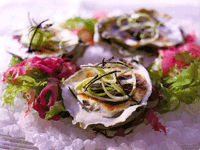 |
|||||
|
|
|
|
|
|
|
Champagne-Baked Oysters
From The Farallon Cookbook by Mark Franz and Lisa Weiss |
||

Ingredients:
12 fresh oysters, shucked, liquor and bottom shells reserved separately4 to 6 cups rock salt
Braised Leeks:
1 large or 2 medium leeks, white part only, halved lengthwise1 tablespoon unsalted butter 1/2 teaspoon chopped fresh thyme Kosher salt and freshly ground pepper to taste
Truffle Glaçage:
1/2 cup heavy cream1 tablespoon Champagne 1 egg yolk Reserved oyster liquor, above 1 teaspoon chopped fresh black truffle or white truffle oil Kosher salt and freshly ground pepper to taste 3 tablespoons finely julienned fresh black truffle, or lightly toasted nori
This and many other wonderful
recipes may be found The Farallon Cookbook from Chronicle Books
|
Chef's Tips: In the ideal world, you would have a 2-ounce fresh black truffle to make this dish. But it can also be made using just 1 teaspoon of white truffle oil. If you have them, black or dark-colored plates that contrast with the white salt look particularly stunning for this dish. For a really special occasion, garnish the dish with caviar.
To prepare the oysters: Rinse, scrub, and dry the reserved oyster shell bottoms. Using a large gratin dish or brollerpan bottom, pour in 2 cups of rock salt and pat into a thick layer. Nestle the shucked oyster-shell bottoms firmly in the salt and set aside. Divide the remaining rock salt between each of the 4 serving plates and set aside while you make the dish.
To prepare the leeks: Cut them crosswise into thin half-circles. Rinse in a colander and dry well. In a small sauté pan or skillet, melt the butter over medium-low heat, add the leeks, and cook until soft but not colored, about 5 minutes. Add the thyme, salt, and pepper and cook for 1 minute. Remove from heat and set aside. To make the glaçage: In a deep bowl, beat the cream until soft peaks form. In a small bowl, whisk the Champagne, egg yolk, reserved oyster liquor, and truffle or truffle oil together. Add to the whipped cream and beat again until the cream begins to hold firm peaks. Season with salt and pepper. Refrigerate for up to 6 hours. To serve, preheat the broiler. Put a little of the sautéed leeks in the bottom of each shell and place a shucked oyster on top of each serving of the leek mixture. Spoon on enough glaçage to cover the oysters. Place the prepared shells under the broiler 4 to 5 inches from the heat source until the glaçage is speckled golden and brown, about 30 seconds. Remove the oysters from the broiler, carefully lift them out of the salt, and arrange 3 in the bed of rock salt on each plate. Garnish with the truffle or nori, if using. Improvisations: If you're in the mood for something less fancy, sautéed spinach would make a good combination with the oysters. You could replace the Champagne with the same still white wine that you might choose to drink with the dish. Garnish simply with fresh chives. Advance Prep: The dish can be made up to the point just before covering the oysters with the glaçage and placing them on the rock salt. Refrigerate for up to 1 hour before serving, but be sure to cool the leek mixture first so that the beat from the leeks doesn't begin to cook the oysters. The glaçage can be refrigerated for up to 6 hours before serving and rewhisked just before serving. Simplifying: The beauty of this dish lies in its simplicity and there's not much you could do to make it easier, but please don't use oysters from a jar. If you're pressed for time, have your fishmonger shuck the oysters for you. Wine Notes: Champagne is the natural choice for this dish, not only because it is used in the recipe but because it is also one of the great food and wine pairings. The second-best foil to the creamy oysters would be a Riesling, another of the most glorious white wines in the world. This dish presents the perfect opportunity to try some good German and Alsatian Rieslings. They combine a purity of fruit and depth of flavor with an acidity that makes them very refreshing, even if there is a bit of residual sugar.
|
|
|
Copyright © 2005 Epicurean.com & Chronicle Books All rights reserved |
|
|